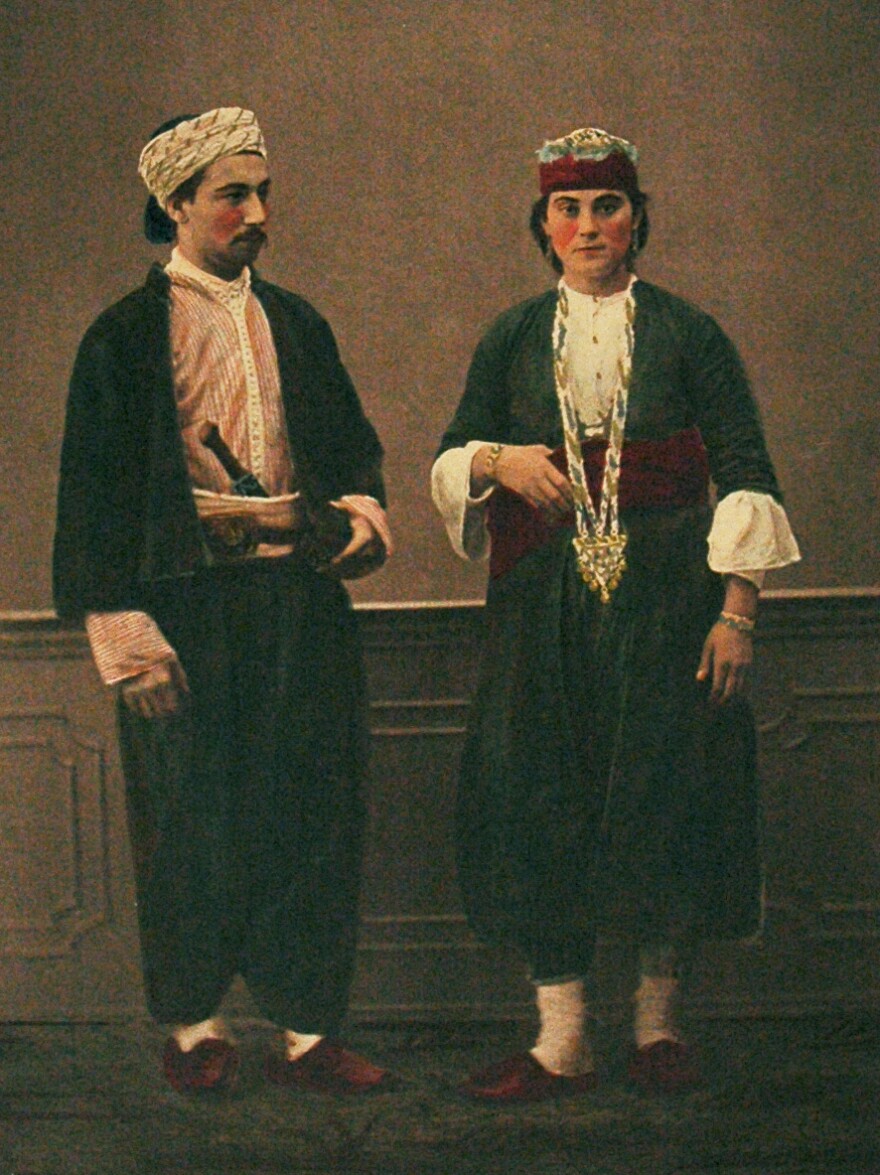Over the past six months, the headlines from Aleppo, Syria, have been horrifying. As the conflict between rebel forces and the government continues, the city has been overrun by tanks and artillery, and assaulted by shots, explosions and fires.
But Aleppo's present belies a much richer past. It's Syria's largest city, and one of the world's oldest continually inhabited urban areas. Over the centuries, it has served as a major crossroads for trade and commerce.
At The Textile Museum in Washington, D.C., there is moving evidence of an earlier, more peaceful time in that now-beleaguered Syrian hub: photographs of 19th century women in gold-trimmed velvet jackets, flowing pants and, on their heads, finely woven skull caps. One such small and brimless cap, made in 1800, is on display at the museum.
Curator Sumru Krody says the floral pattern — tulips mostly — is typical of Ottoman Empire design. The cap's flowers are framed in deep reds, rich browns. "It's all silk and metallic threads," Krody says. "And a very little hint of pink."
A woman of means might have worn it — the silvery threads were costly. In 1800, she lived in a lively town at the end of the legendary Silk Road, a bustling trade route from China to Europe and beyond. Her markets, in Aleppo, offered exotic wares from all over the world. Carefully chaperoned, the woman in the woven cap could have bought just about anything.
Heghnar Watenpaugh, professor of art history at the University of California, Davis, paints a picture of life in old Aleppo.
"If you were tired of shopping, you might stroll down the beautiful, new, wide streets and relax in a cafe and consume coffee, which was a beverage that was gaining a lot of popularity around the world at the time, and Aleppo was the center for the trade of coffee," she says. "You'd be able to hear ... some music performed there, or a professional storyteller."
Watenpaugh says she likes to compare Aleppo to Chicago.

"It is connected to various transportation pathways, both by sea and by land," she says. "It's a center of manufacture. It's also a center of trade, it's a center of business. It attracts all kinds of people."
In 1800, when the tapestry cap was made (imagine its long, silken tassel shimmering in the sun), Aleppo was a major textile center, dotted with workshops where silk was woven and crafted. Today's Aleppo is still a city of traders, but NPR's Kelly McEvers, back from a recent reporting trip, says punishing government attacks on rebels there have bombed and shelled parts of town into oblivion.
"You see entire buildings just crumpled to the ground," says McEvers. "Entire floors ... shorn off the top of a tall apartment building, or just the face of a building, just completely blown off. I mean, there are neighborhoods that are absolute wastelands ... water mains blown and leaking under the streets, piles and piles of rubble and garbage. Not a single civilian in sight. Men with guns, just roaming the streets ... basically like they own the place."
Aleppo came late into the nearly 2-year-old Syrian conflict. In the summer of 2012, rebels tried to carry their revolution there. But McEvers says Aleppo's middle-class merchants were reluctant to take sides. And the rebels hadn't paved a path for themselves in advance.
"They didn't really prepare anyone for this," McEvers says of the rebels. "They didn't prepare the political ground in the city. They didn't have the hearts and minds of the people, so when they came in, they weren't met with open arms."

And so today Aleppo is a divided city, half controlled by rebels, half by the government. The rebels are taking their fight to airbases on the outskirts, trying to stop attacks from the sky.
And yet, this ancient city — its history goes back to the Bronze Age — has a resilience crafted by the centuries. According to Watenpaugh, Aleppo "did not become the oldest inhabited city in the world by always staying the same. Like all vibrant cities, it is constantly in the process of reinventing itself. And war — civil war — is one of the ways in which a city, perhaps negatively, perhaps violently, reinvents itself."
Watenpaugh suspects that the Aleppo that will emerge from this conflict will be a different incarnation of the ancient city.
"We don't know what it will be," says Watenpaugh. "But we have to hope that it will continue to be the genius of the place that continues to reinvent itself and find new ways of expressing its energy."
McEvers saw signs of that on certain Aleppo streets recently: people trying to get back to normal.
"This is a city of merchants," says McEvers. "A city of people who, for a really long time, have figured out how to get by, and in some places we saw that they're doing that now."
Those workshops where the tapestry cap with the tassel was produced 200 years ago, those bazaars and coffee shops where the woman who wore that cap did her shopping and stopped for coffee or a story on a busy day, gave 19th century Aleppo a fragrant texture and beauty. A single object, of silk and silver, speaks of what once was — and might, someday, be again.
Copyright 2022 NPR. To see more, visit https://www.npr.org.



